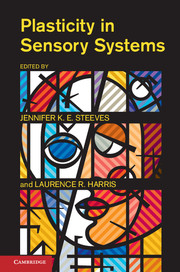Book contents
- Frontmatter
- Contents
- List of Contributors
- 1 Plasticity in Sensory Systems
- I VISUAL AND VISUOMOTOR PLASTICITY
- II PLASTICITY IN CHILDHOOD
- III PLASTICITY IN ADULTHOOD AND VISION REHABILITATION
- 9 Visual Plasticity of the Adult Brain
- 10 Beyond the Critical Period: Acquiring Stereopsis in Adulthood
- 11 Plasticity and Restoration after Visual System Damage: Clinical Applications of the “Residual Vision Activation Theory”
- 12 Applying Plasticity to Visual Rehabilitation in Adulthood
- Author Index
- Subject Index
- References
12 - Applying Plasticity to Visual Rehabilitation in Adulthood
from III - PLASTICITY IN ADULTHOOD AND VISION REHABILITATION
Published online by Cambridge University Press: 05 January 2013
- Frontmatter
- Contents
- List of Contributors
- 1 Plasticity in Sensory Systems
- I VISUAL AND VISUOMOTOR PLASTICITY
- II PLASTICITY IN CHILDHOOD
- III PLASTICITY IN ADULTHOOD AND VISION REHABILITATION
- 9 Visual Plasticity of the Adult Brain
- 10 Beyond the Critical Period: Acquiring Stereopsis in Adulthood
- 11 Plasticity and Restoration after Visual System Damage: Clinical Applications of the “Residual Vision Activation Theory”
- 12 Applying Plasticity to Visual Rehabilitation in Adulthood
- Author Index
- Subject Index
- References
Summary
Introduction
Severe visual impairments varying in etiology and intensity, affect more than 280 million people worldwide (World Health Organization [WHO], 2011; Elkhayat, 2012). Although, as described in other chapters in this book, the brain of the blind undergoes massive plastic changes in an effort to compensate for the lack of vision, providing increased support for other senses and abilities, the blind and visually impaired remain significantly limited in their ability to perform tasks ranging from navigation and orientation to object recognition. Thus, the blind are prevented from fully taking part in modern society, constituting a major clinical and scientific challenge to develop effective visual rehabilitation techniques for them. Many attempts have been made to help the blind using a wide variety of different approaches; however, unfortunately, until recent years most have born discouraging results. This chapter discusses if and how the plasticity described in this book can be harnessed for visual rehabilitation in adulthood to enable the blind to use their own brain to process “raw” visual information, despite the discouraging outcome of past attempts. We describe several different approaches to visual rehabilitation and their practical real world and clinical results, focusing on sensory substitution devices and their potential. We then show some examples of what using these devices has taught us about the brain, offering a theoretical basis for their empirical results, and finish with some practical conclusions and recommendations for future visual rehabilitation attempts.
- Type
- Chapter
- Information
- Plasticity in Sensory Systems , pp. 229 - 254Publisher: Cambridge University PressPrint publication year: 2012
References
- 2
- Cited by

